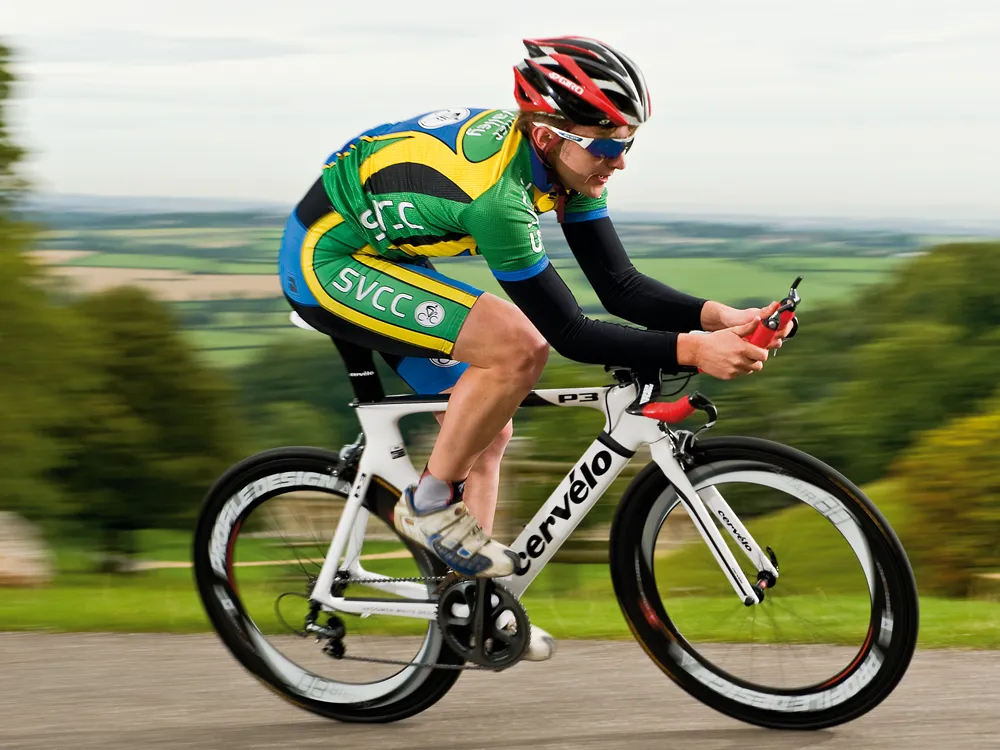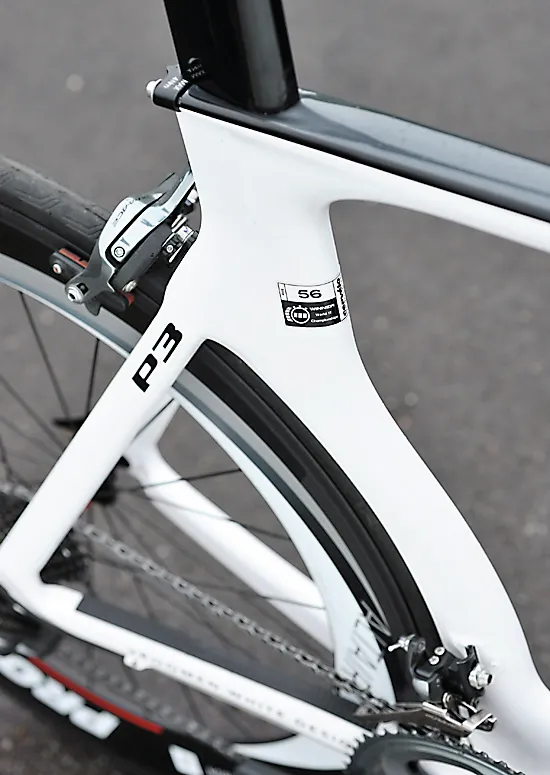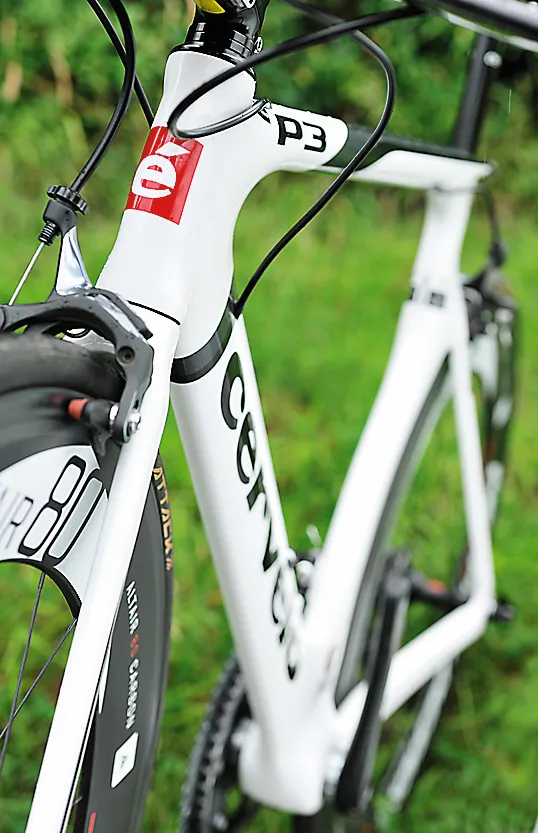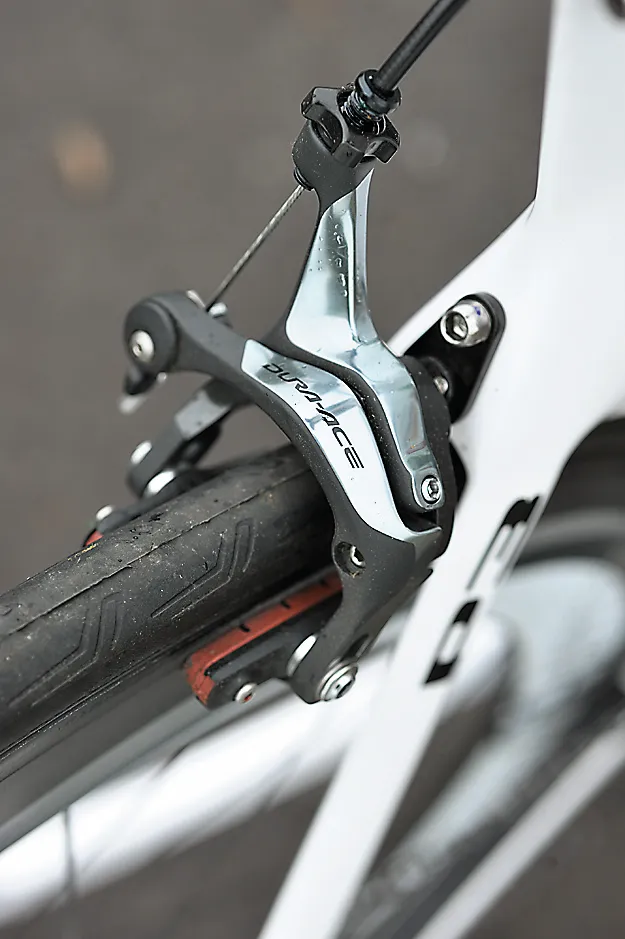Cervélo charge a premium for their wind-beating warhorse the P3C. While several aero boxes aren't ticked, the position, propulsive delivery and precision handling still build into a blisteringly quick machine well worth its money.
Ride & handling: Impressively light, phenomenal handling and crisp controls
The good news on gusty days is that riding the P3 is as close as you’ll get to feeling like you’re in a custom race car seat. Cervélo worked very hard on clean sheet ergonomics for the P series bikes, and it shows immediately. Rather than relying on muscle and grip, arms, shoulders, back and pelvis all fall into place perfectly with a limb-locking security that any mad scientist’s lab would be envious of.
Although the relatively heavy, slow accelerating wheels are obvious, the low frame weight makes it as ready for hilly or short-course work as tackling hours of lava-field furnace. Add dramatic drive stiffness clearly transmitted though the soles of your shoes as soon as you click into the pedals, and the feel is pure propulsion.
The P3 squeezes forwards with undiluted intent from the first muscle pulse and there’s an overwhelming feel that you’re surfing the sweet spot of a potentially massive wave of speed. How far you can ride that wave depends on how fast you can spin the pedals. The unmistakable feeling that the bike is pushing you forward rather than holding you back makes a massive difference when it comes to encouraging you to dig deeper.
Even testers coming unravelled at the end of hardcore training weeks couldn’t help but go into combat mode and send the Cervélo screaming into the distance on group rides. The handling is not only very well-balanced and stable enough to run deep wheels in ropey conditions, it’s also unerringly precise and accurate.
Add sharp, powerful braking and you can shove straight-line speed right down the throat of the deepest corners or slingshot though mini-roundabouts at stomach-churning speeds. This lets you carry your attack on the clock right through areas that are normally a momentum-killing frustration, and reinforces the predatory feel of the P3C.
With so much raw speed and snarling, bared-teeth aggression, we’d forgive the Cervélo for occasionally biting the hand that feeds it, but overall ride rigidity isn’t too fierce. It’s no leatherette couch over rougher surfaces, and you need to be aware of tarmac trauma hurtling down the road towards you. On average roads there’s enough damping to keep you spinning smoothly and fight off skeletal fatigue for as long as your bike leg takes.
Chassis: Not as aero or comfortable as the best contemporary frames
The P3C's down-tube-inserted cabling and straight gauge headset are starting to look dated compared to the behind-the-stem control routing and tapered fork tops found on newer aero designs. The bottom bracket is still conventional too, rather than press-fit, oversized, or both. There are no integrated components either, and even the brakes are conventional items in conventional positions.
Despite being widely copied by other brands, the rearward-extended wheelhugger curve with vertical aero seatpost still drives a visually dramatic stake through drag coefficients. Each section of each tube, from hourglass head tube to super-thin rear stays, is honed into a very efficient true aero form, relevant to real bike speeds rather than auto or aeronautical research. The twin-position seatpost gives the option of a triathlon-style 78-degree seat angle or more conventional time trial 75-degree option too.
Hidden wheel adjusters, neat seatpost clamp and clean, straight cable runs make the bike very easy to work on and functionally very efficient, rather than just a slave to streamlining. There are no clearance issues with the latest fat rim wheels from Zipp, HED, SRAM, ENVE etc either. Despite being several years old, Cervélo’s Smart Wall butted wall tubing means it’s still one of the lightest aero frames available.
Cervélo's distributors, Madison, also handle all the Shimano sales for the UK, so it’s no surprise our demo frame came loaded with full Dura-Ace stop/go kit. While Di2 electronic gears with additional base bar shifters are undoubtedly the ultimate Shimano option for aero bikes, in terms of analogue systems DA is still impossible to beat for feather-light shifting accuracy. Short, straight-as-possible cable routing makes the brakes feel outstandingly precise and controlled compared to more convoluted aero setups too.
The carbon stem and cockpit are from the top rank of the extensive Madison-distributed Profile cockpit family, and perform accordingly. The Profile Altair 80 wheels are a good-looking set, but performance is average rather than exceptional. Straightline drag is low, but they’re not particularly light and their flat-sided gust-prone design was definitely a test of the Cervélo’s handling balance on more turbulent and exposed test runs.




